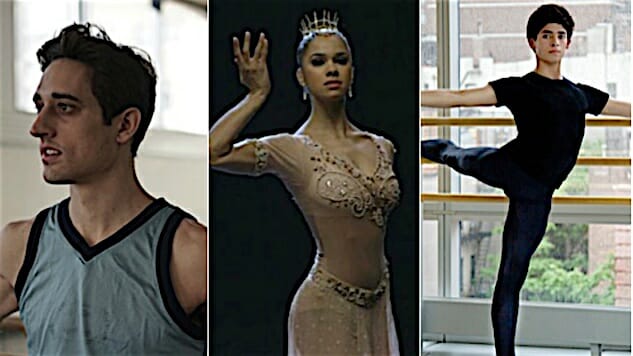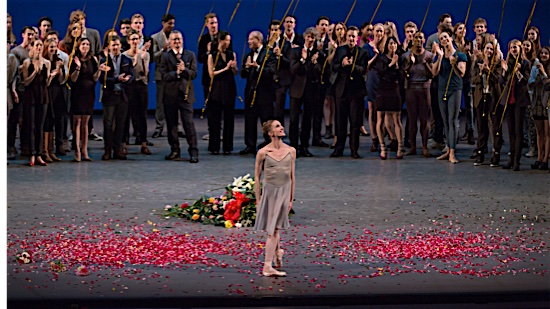
Let’s face it, for the average moviegoer—and probably the average person, in general—ballet is an art form less grasped in its essence than shallowly encountered via cliché and assumption. But anyone who dances or spends a little time following the form knows better. Ballet may have fallen behind movies, musicals, sporting events and, well, lots of things when it comes to occupying a prime position in the entertainment and enlightenment of the masses, but that doesn’t make it any less compelling a subject for filmmakers, as these five documentaries on ballet make evident.
1. Ballet 422 (2015)

In Ballet 422, director Jody Lee Lipes (who recently served as DP on Manchester by the Sea) does something remarkable: He cuts himself out of the equation entirely. He’s barely a fly on the wall in his own documentary, which chronicles New York City Ballet soloist and choreographer Justin Peck’s attempt to architect the company’s 422nd production. Lipes’s approach to capturing his subjects is about as modest as humanly possible, though describing his results as “modest” would be totally unfair. Ballet 422 lacks the traditional hallmarks of most standard documentary films, eschewing talking head interviews and recurring streams of title cards crafted to hand-hold the audience through learning, and that’s what makes it such a gem. —Andy Crump
2. First Position (2012)

First Position takes a look behind the scenes as six young dancers prepare to compete in the Youth America Grand Prix in New York City, the world’s largest student ballet scholarship competition. Directed by Bess Kargman, the documentary follows these performers as they tirelessly train all over the world in the hopes of winning awards, scholarships to prestigious dance schools, or even a chance to be placed in a professional ballet company. The film revolves around the lives of Aran, Gaya, Michaela, Miko, Rebecca and Joan, and provides an interesting window into the intense labor these children put into crafting performances that are meant to look beautiful and effortless. First Position is entertaining—all six children are superb dancers with bright futures in dance ahead of them—but it ultimately lacks any real sense of adversity or rejection that would give this exploration of the oft-clichéd world of ballet real depth. —Emily Kirkpatrick
3. Restless Creature: Wendy Whalen (2017)

Restless Creature: Wendy Whelan isn’t a “dance movie,” per se. Except during the last 10 minutes (and even then, in what looks like a truncated form), there aren’t really any sustained ballet sequences in which to marvel at the former New York City Ballet principal dancer’s legendary physicality. It’s doubtful that neophytes will come away from Adam Schlesinger and Linda Saffire’s documentary with a deeper appreciation of the art form. Instead, this is a portrait of an artist at a professional and personal crossroads, as Whelan faces the potential death of the creative livelihood that has sustained her for so many decades, one that has given her life joy and meaning. “If I don’t dance, I’d rather die,” says Whelan early in Restless Creature, which is enough to indicate to us the depth of her passion for dance. She lives and breathes ballet, so when, sometime in 2012, she begins to experience bodily injuries that threaten to end her career altogether, the desperation she evinces as she sees doctors and eventually undergoes hip surgery—a procedure which none of the doctors can guarantee will ensure that she will return to the dance floor—helps infuse this film with palpable life-or-death stakes.
Whelan’s process of trying to rediscover herself after a personal setback would not have been half as involving as it is if she hadn’t been so generous with the access she granted the filmmakers. Whelan isn’t afraid to lay bare her vulnerabilities for the camera, and Schlesinger and Saffire are able to capture their subject in occasional private moments. It’s that intimacy that makes Restless Creature: Wendy Whelan an artist documentary that will play movingly—inspiringly, even—for those who aren’t already fans. —Kenji Fujishima
4. A Ballerina’s Tale (2014)

It’s easy to forget when watching any ballet performance how such effortless movement and motion came to be: Hours upon hours fall behind every curtain rise. The same goes for Nelson George’s documentary, A Ballerina’s Tale. Gone are the thousands of moments that led to dancer Misty Copeland’s moment in the spotlight at the American Ballet Theatre—what remains on the stage is only her performance in front of an enraptured audience. But what sets A Ballerina’s Tale, hers, apart from those of the background corps of lily white and willow wisp bodies before her are the monumental barriers now crumbling at the toe of Copeland’s ballet slippers. The movie follows Copeland on stage and off during an unprecedented chapter in ballet history. She’s not only one of the few African-American dancers to land a spot in one of the ballet world’s most coveted rosters, she’s ABT’s first African-American principal. From her beginnings in an after school program, at an age well past the prime for learning how to bind her toes and sew on the laces of her first pair of pointe shoes, to conquering judgments about her skin and body type, her story is a remarkable one.
Sadly, little of Copeland’s on-stage performances are actually to be seen after all the time the film takes to build up to them. A Ballerina’s Tale also struggles to get past constant adoration to get to know Copeland the human being. The moments we do get are real gems, such as when the world-famous ballerina strolls through Central Park with a camera, unbothered, confessing her concerns about her promising future. Another is when she unabashedly enjoys a donut—perhaps another never-before-seen moment in ballet history.
The typical hero’s journey makes myths out of mortals, but it’s misplaced here. Part of Misty Copeland’s appeal is that she is so relatable: She doesn’t look like the standard Balanchine ballerina. Still, she has dance left in her, and an outspoken activist streak that can speak to the work that needs to be done in the upper echelons of dance. —Monica Castillo
5. La Danse: The Paris Opera Ballet (2009)

There are documentaries and then there are Frederick Wiseman documentaries. In La Danse: The Paris Opera Ballet, the legendary chronicler of institutions and the people who inhabit them brings his lens to bear on Ballet de l’Opéra National de Paris during its production of seven ballets. Where so many films on this list focus on individual stories to provide the documentary’s narrative engine, Wiseman’s doc strives to captures the organic life of the institution itself. The result, as is typical of so many of Wiseman’s films, is a uniquely enlightening look into both the parts and the whole. Even if you’ve seen all the other ballet docs out there, La Danse will reveal things about the art and its practitioners yet unseen. —Michael Burgin